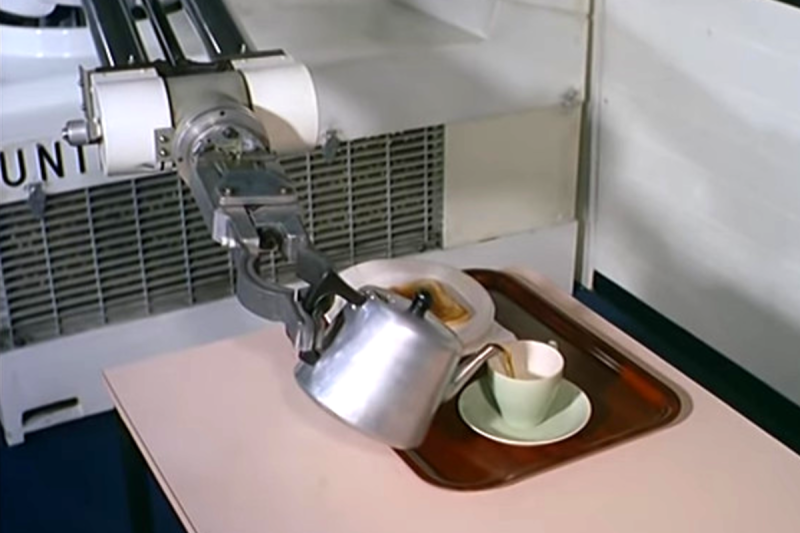Do you know the name [George Devol]? Probably not. In 1961 he received a patent for “Programmed Article Transfer.” We’d call his invention the first robot arm, and its name was the Unimate. Unlike some inventors, this wasn’t some unrealized dream. [Devol’s] arm went to work in New Jersey at a GM plant. The 4,000 pound arm cost $25,000 and stacked hot metal parts. With tubes and hydraulics, we imagine it was a lot of work to keep it working. On the other hand, about 450 of the arms eventually went to work somewhere.
The Unimate became a celebrity with an appearance in at least one newsreel — see below — and the Johnny Carson show. Predictably, the robot in the newsreel was pouring drinks.
The robot actually dated back to 1954, although the patent didn’t grant until 1961. By 1969, GM was even using Unimate to do spot welding and could build 110 cars per hour. At the time this was claimed to be double the rate any other car factory could manage.
The newsreel mentions that the Unimate had memory onboard, and from what we can tell it did use a drum memory system of some kind. We also caught a glimpse of the Unimate making sinks and even (blush) reproducing.
If you watch a bit of that video, you’ll learn that we were supposed to have one of these in our home by the year 2000. Huh. We only wish it had asked, “Would you like some toast?” By the end, though, there was still alcohol involved.
Westinghouse bought Unimate back in 1984. Why not? They always did like robots. We still don’t have robot toasters from Westinghouse or anyone else, for that matter. But they weren’t the first to have an off prediction about the future.
















>we were supposed to have one of these in our home by the year 2000
I don’t think they meant it quite like that. They even say they’re not advocating to actually have a Unimate at home, but simply to imagine that a home could have robots to illustrate the point that the robot can do very fine tasks like (almost) buttering a toast and only barely not tipping a cider bottle off of a fridge while setting it down, and then spilling half the glass on the floor as it serves it to the missus.
You’ll be happy to know that the GM plant in NJ this went into work at no longer exists. it was torn down in 2009 and only within the last few years after a lot of red tape from local politics and a court case did a shopping center take hold on the plot of land, with Walmart as the big anchor store, moving from a different shopping center a quarter mile away. Also on the plot of land are warehouses, notably one for Blue Apron. It saddens me this is the case because that land is practically hallowed ground. Said GM plant made a lot of planes that flew in WWII and gave life to the airport across the highway from it. I have family members who are long deceased that were part of the local “rosie the riveter” group.
LOL, the second video (one-armed bandit) at 1:20 minutes in… First they cleverly cut away the robot arm actually *applying* the butter. And then they make the robot pick up the plate with the toast and swoop it 180 degrees. Oh sure, and we have to believe that toast WASN’T glued to the plate in order to not end up stuck to the wall? :) :) :)
Also notice the robot’s minder entering the shot at 2:52, ready to catch the bottle that nearly falls off the top of the fridge :)
Also the glass was definitely refilled between the pouring shot and the shot showing it being taken by the human. There wasn’t nearly that much left after the previous maneuvers.
That said I’m pretty surprised I didn’t see any tape marks or other indicators of where the props were to be set. There must have been a lot of “standing within the working envelope of a powered industrial robot” to do all the setup.
Now we need a HaD article on the G.E. Man-Mate Industrial Manipulator
I am curious about the “GKN” on the side. Is that Guest Keen and Nettlefolds (one of the UKs oldest companies, founded 1759) or some other GKN?
According to this article, yes: https://www.roboticsbusinessreview.com/manufacturing/the_first_industrial_robot_why_it_failed/
Wow, that’s a pretty interesting article.